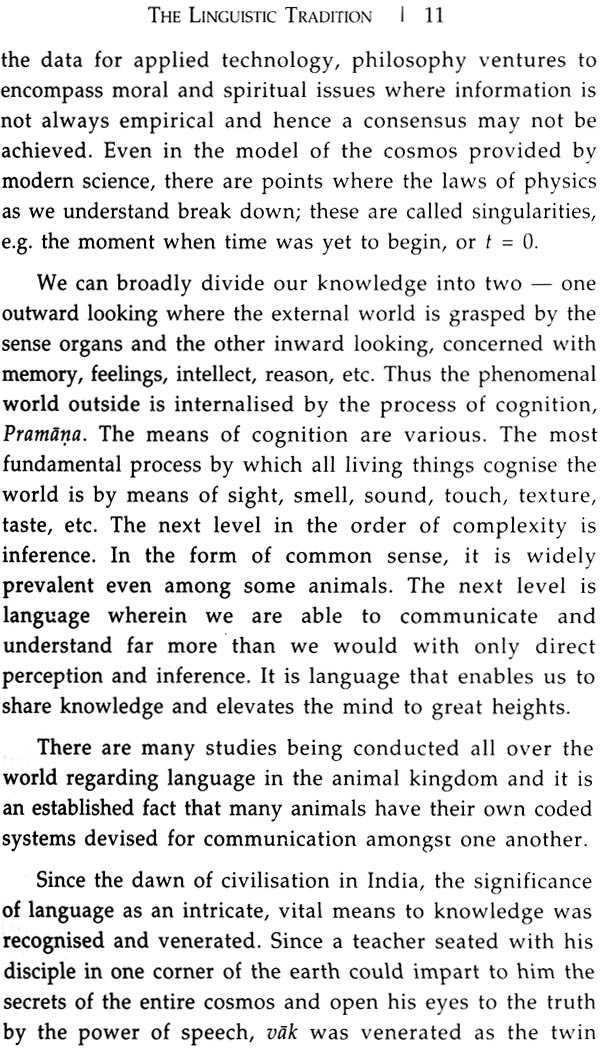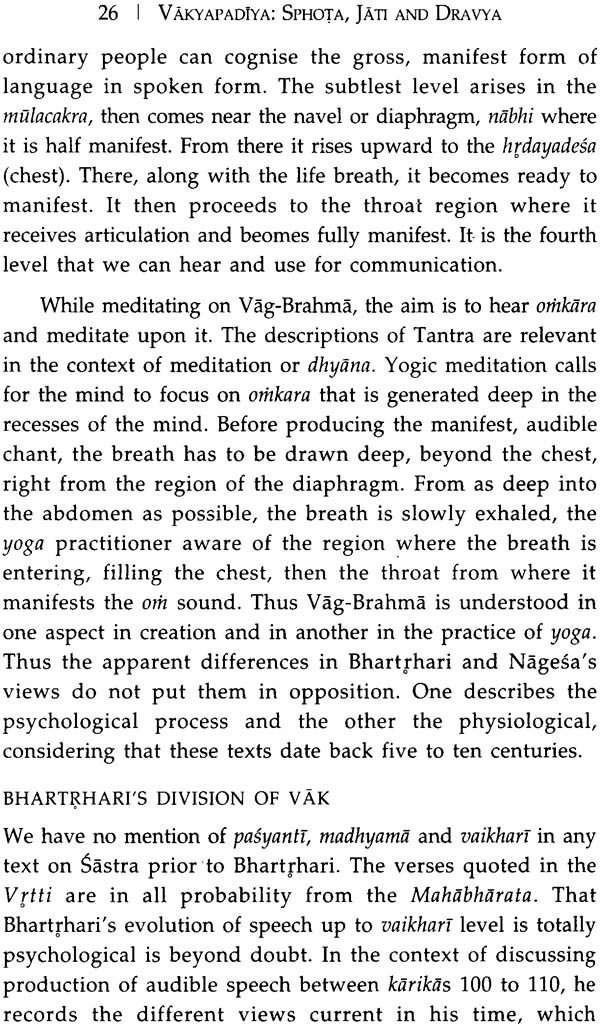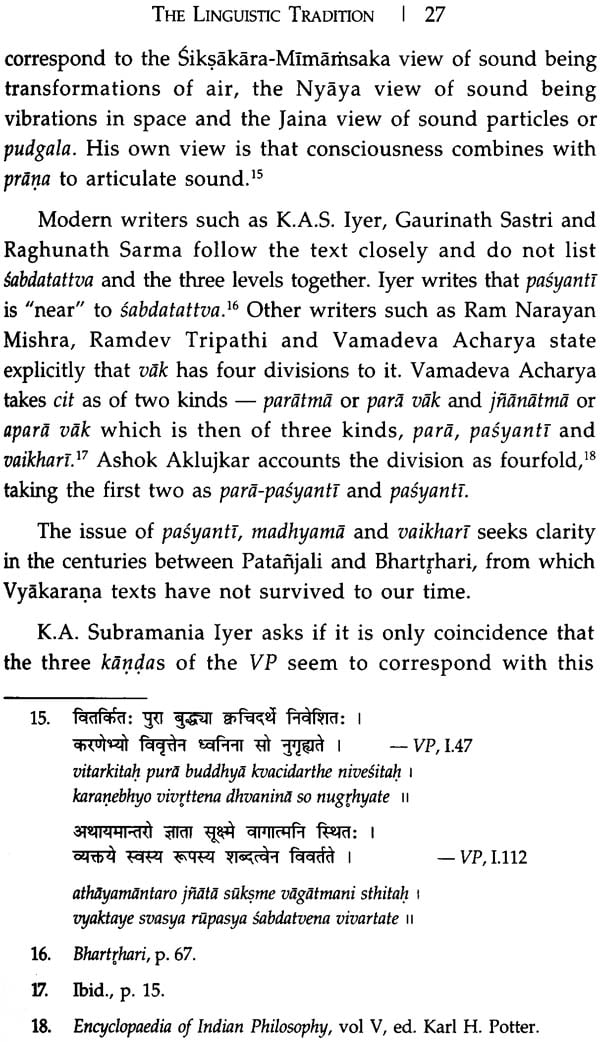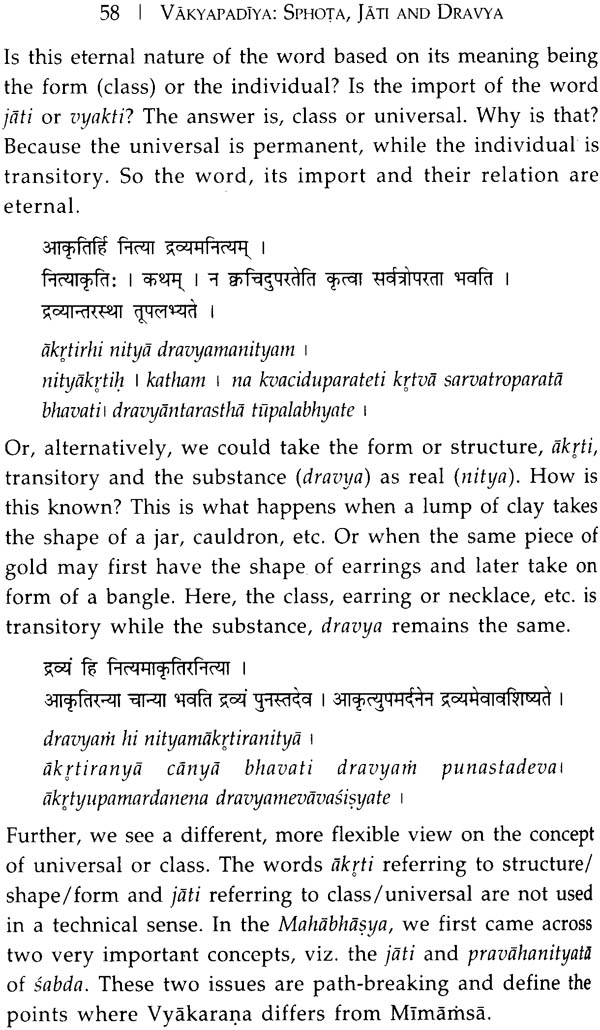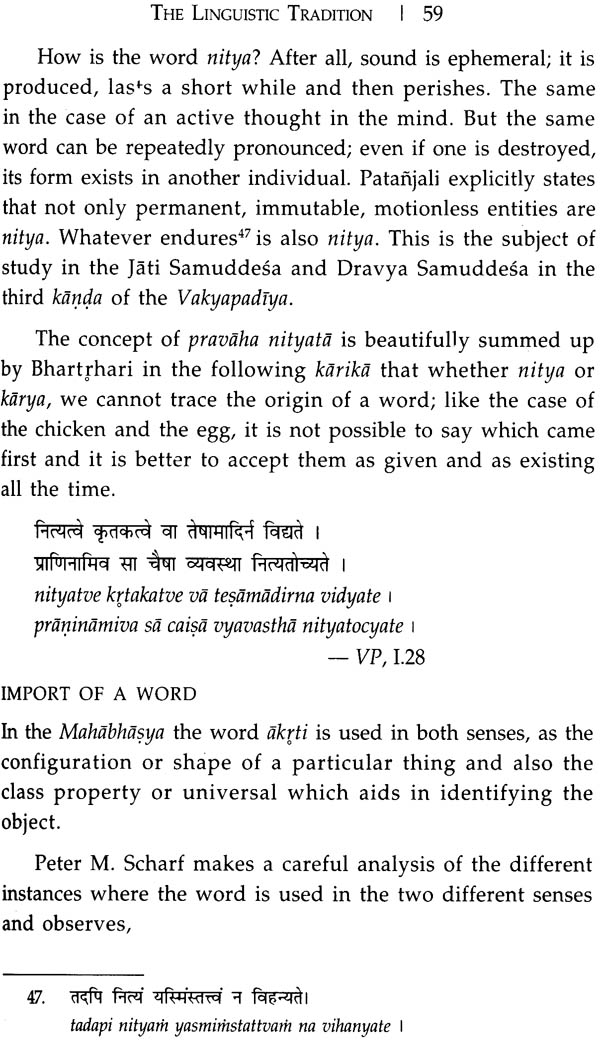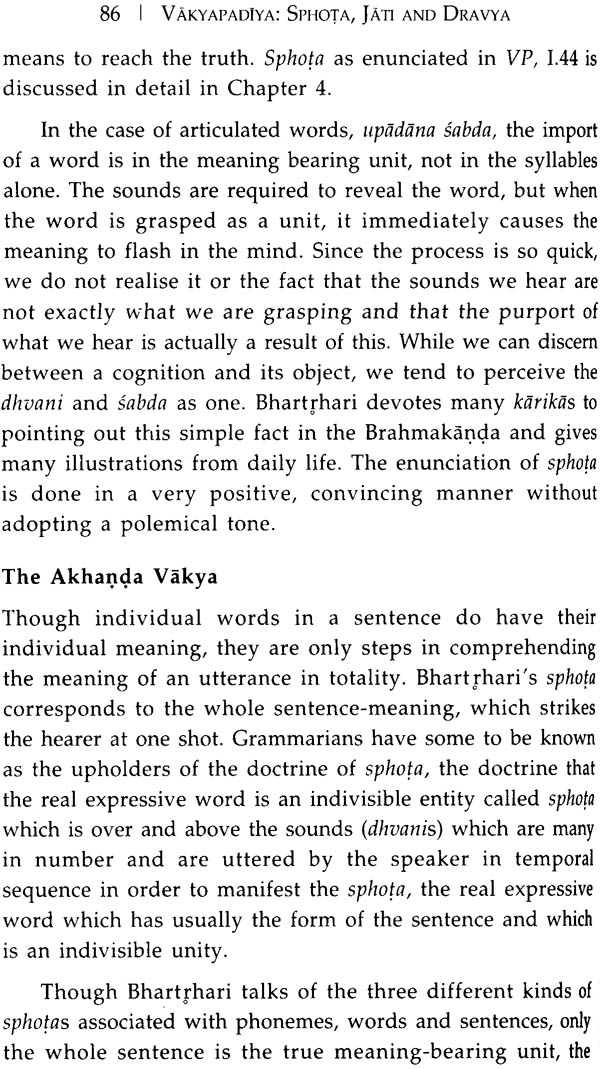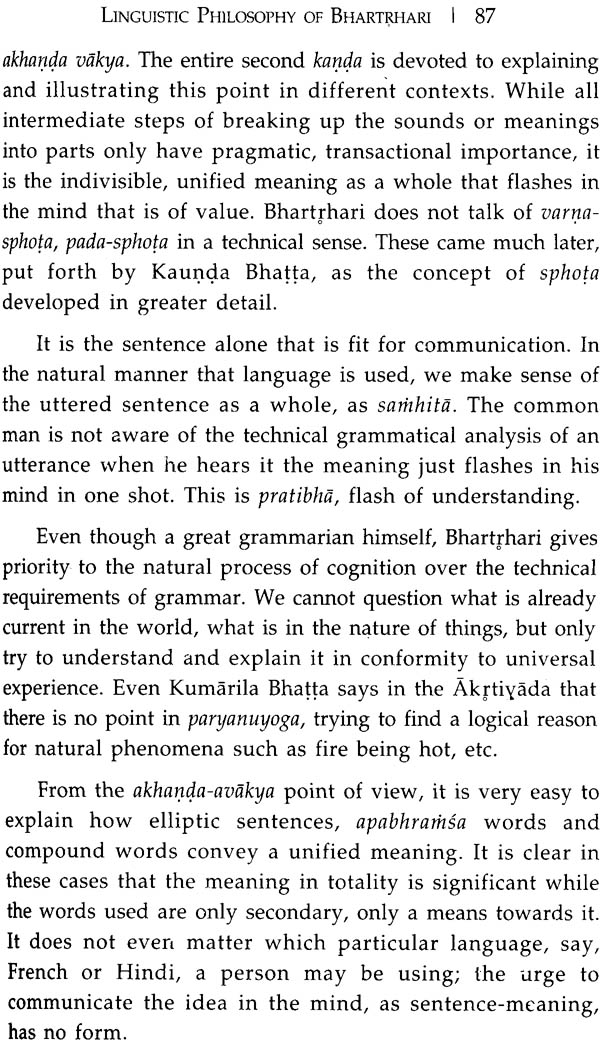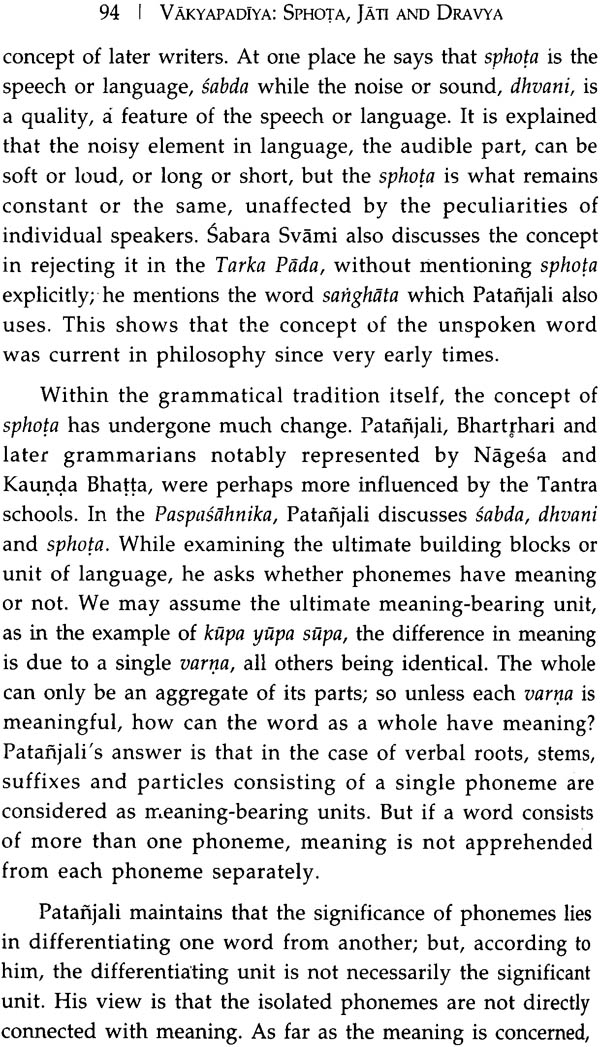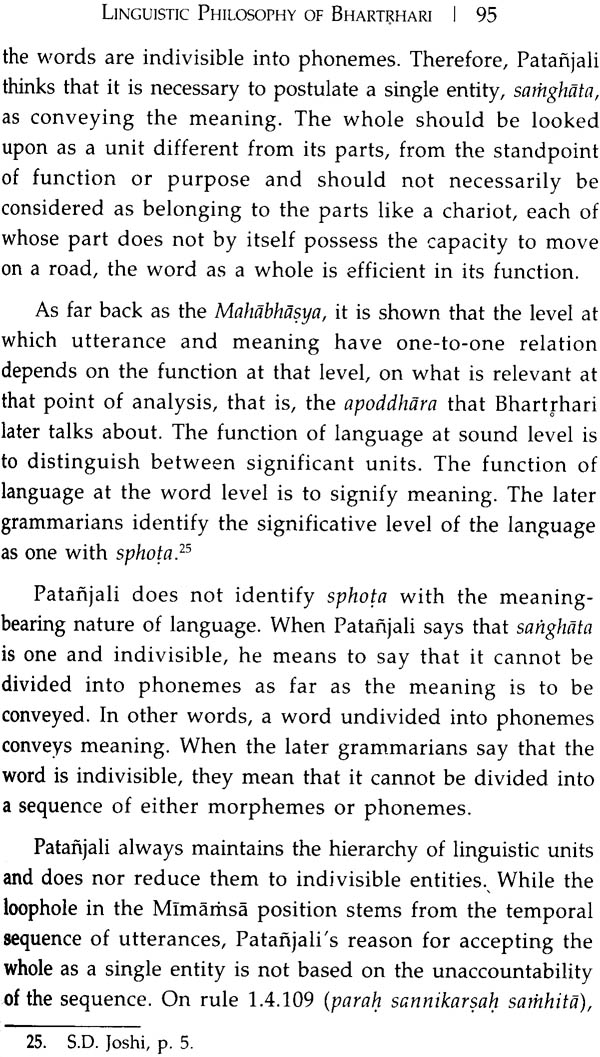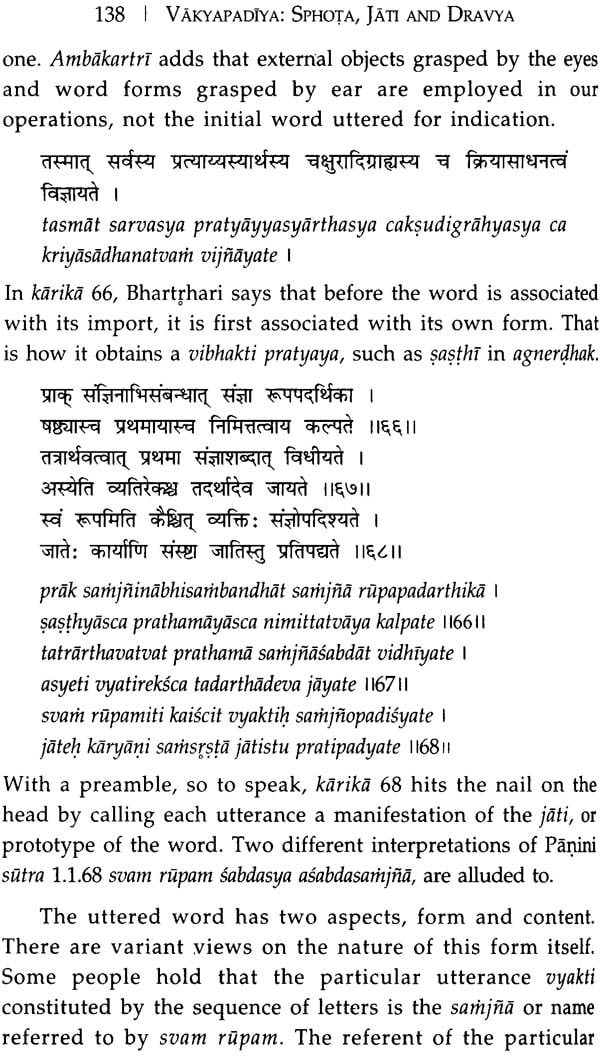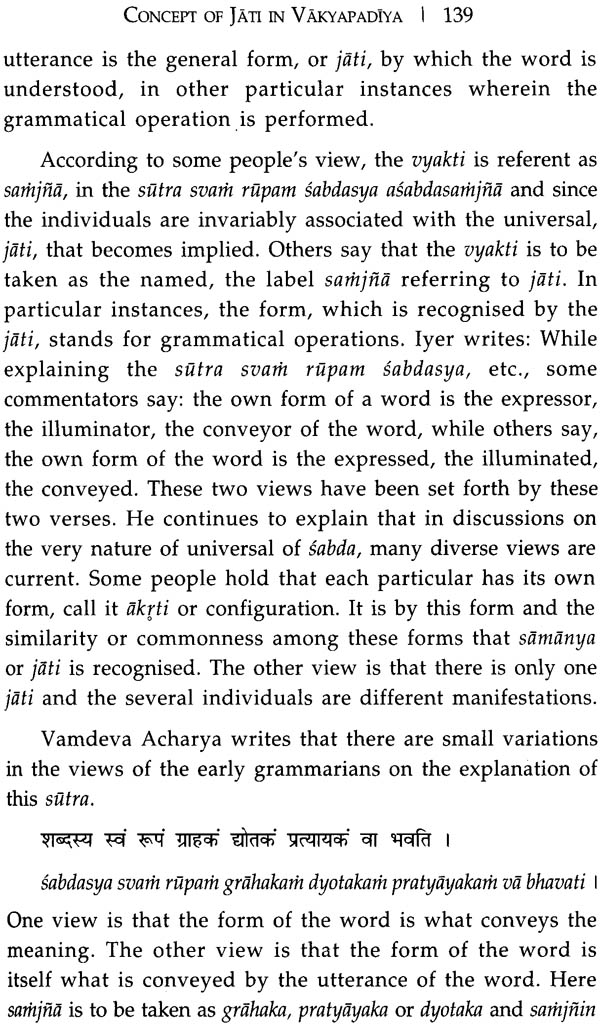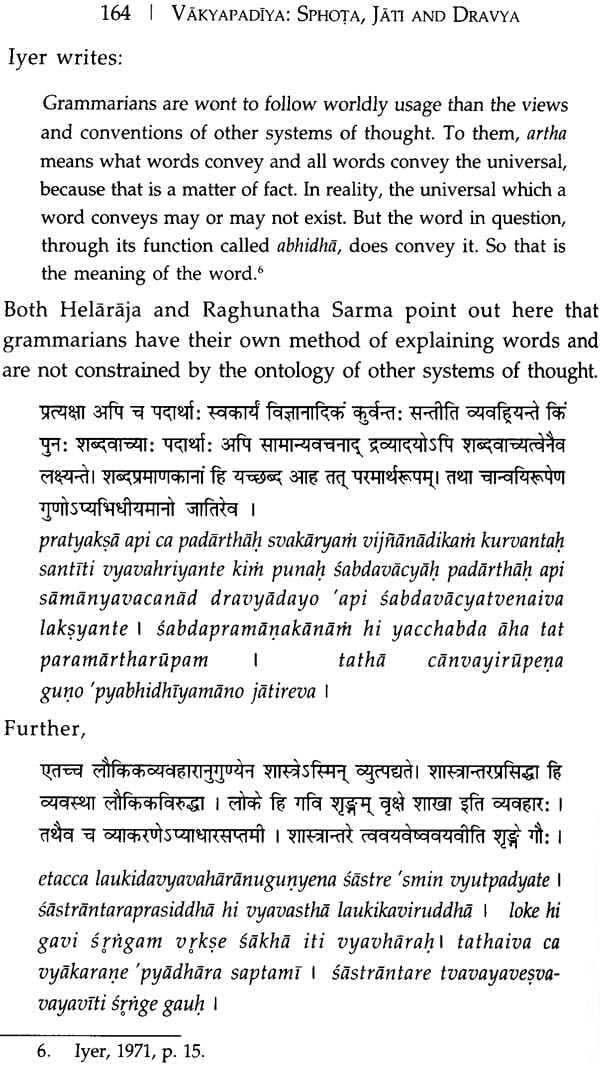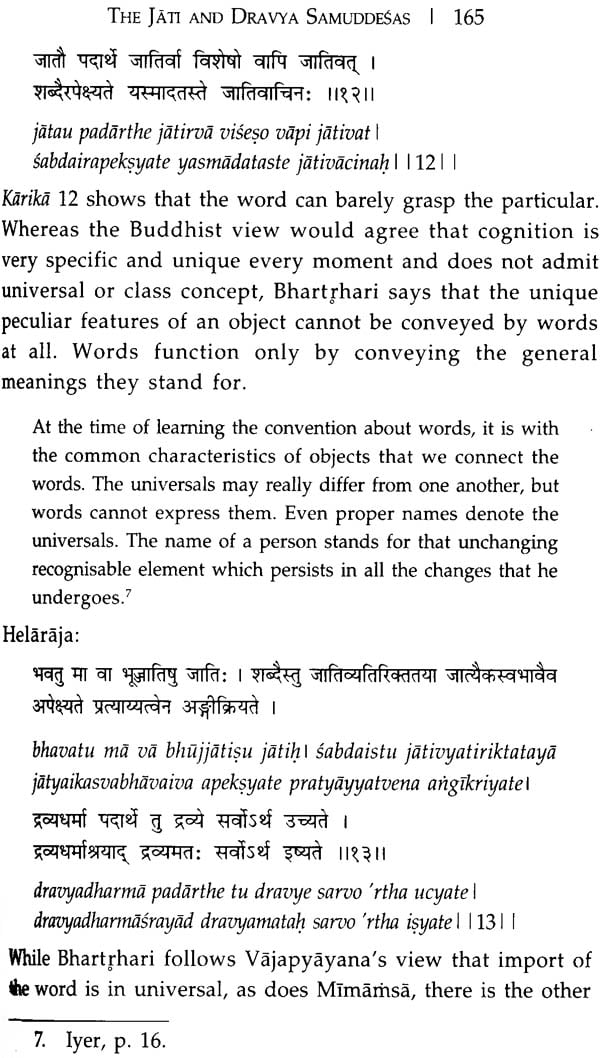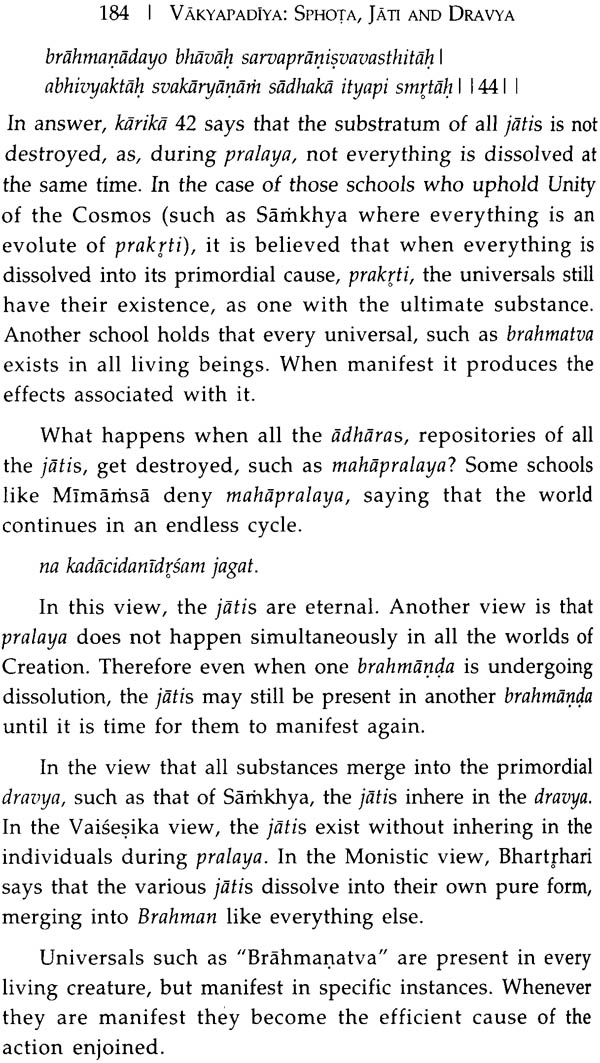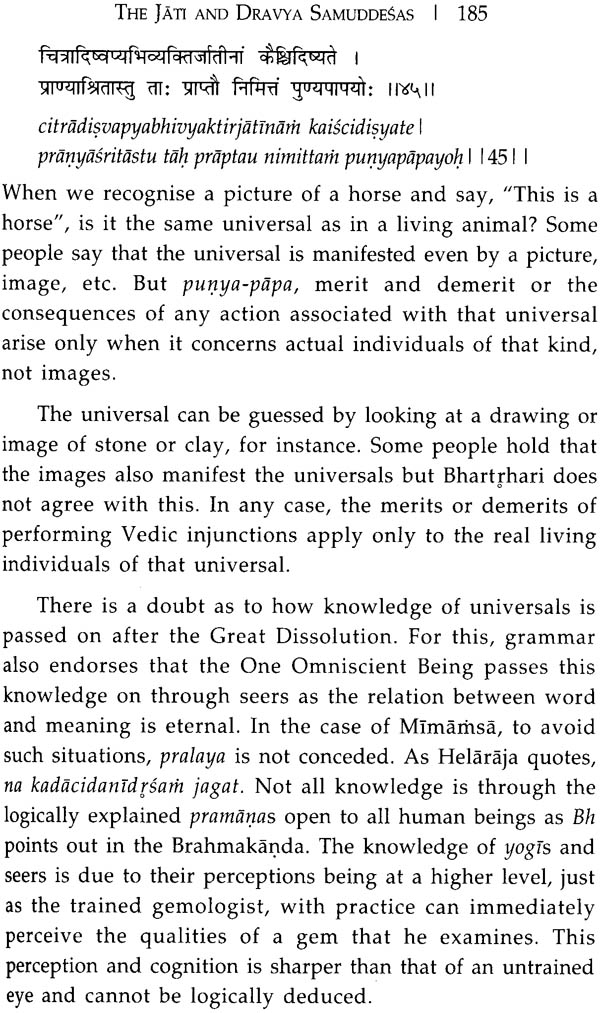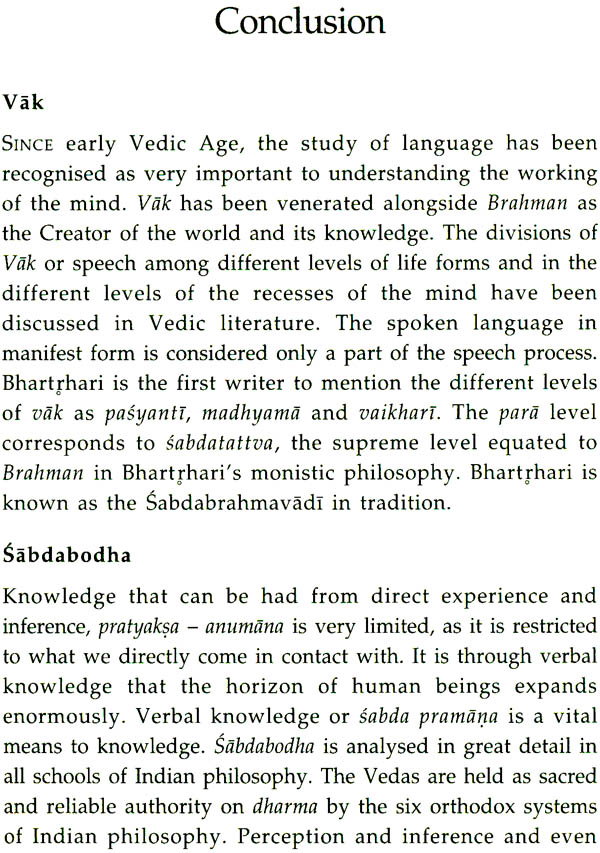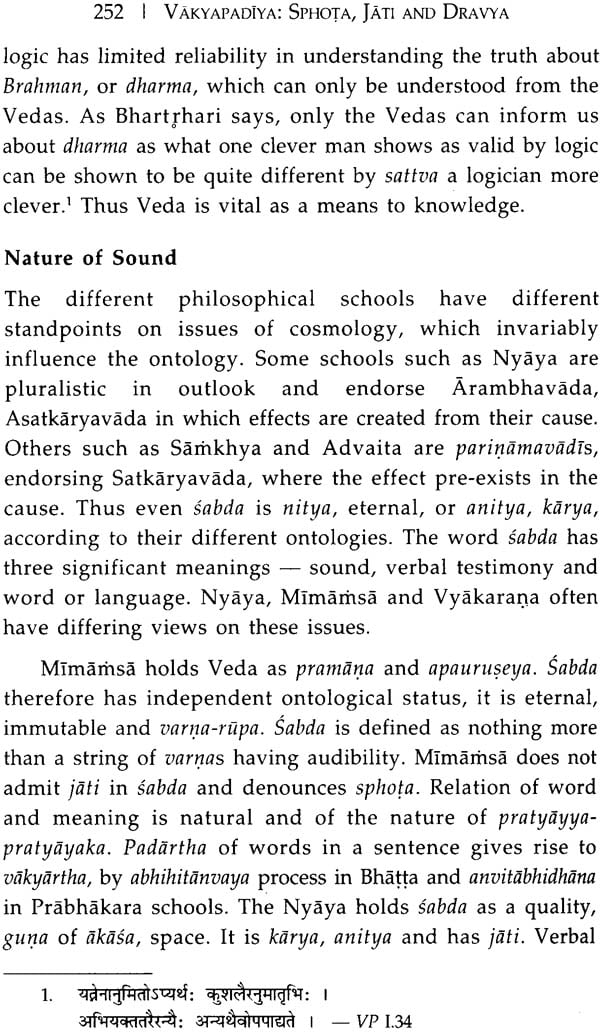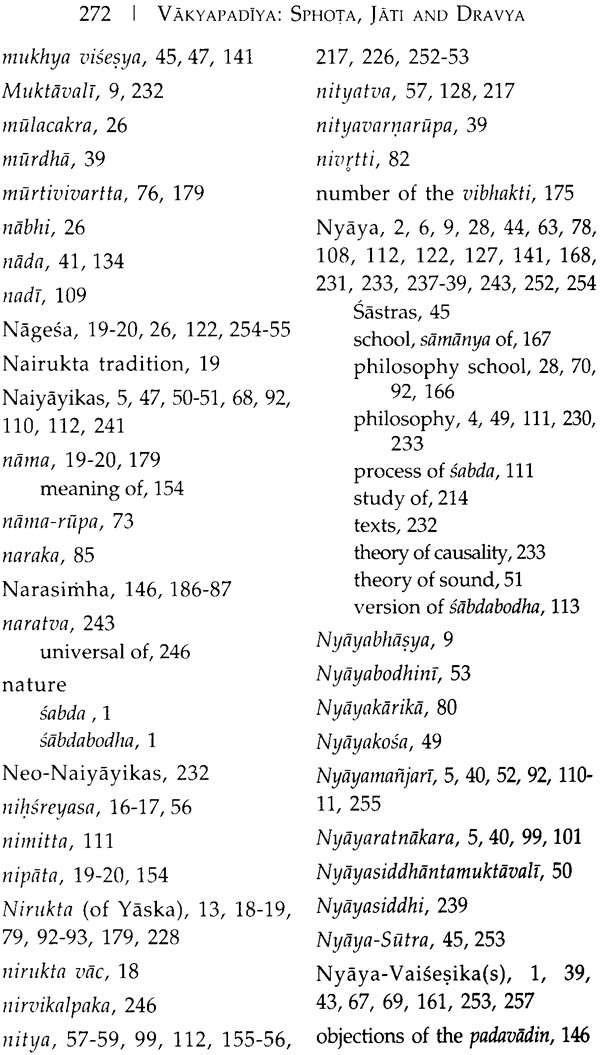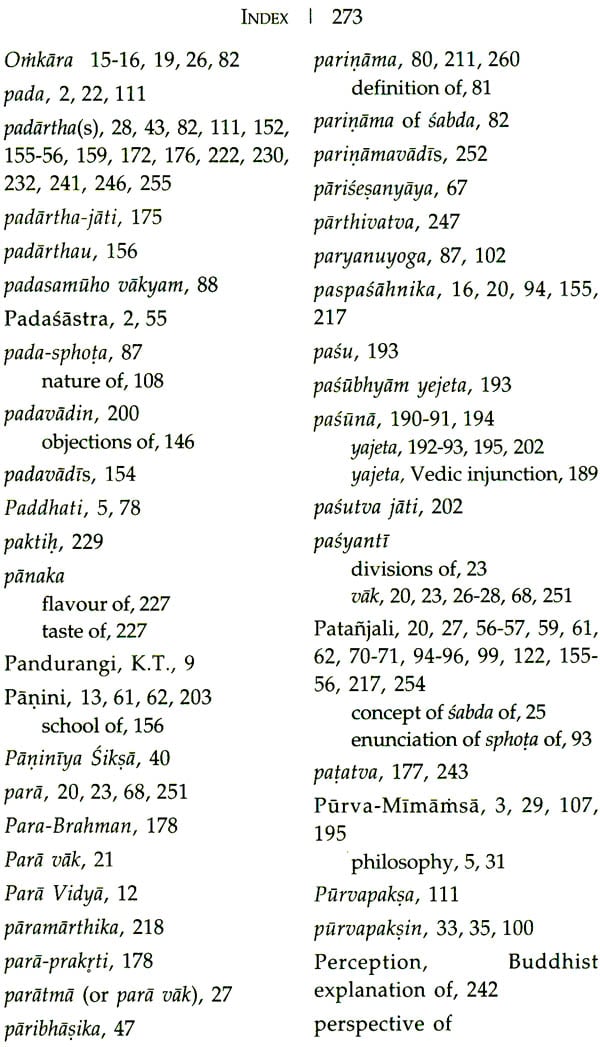
Vakyapadiya: Sphota, Jati and Dravya ((With Transliteration))
Book Specification
| Item Code: | NAC899 |
| Author: | Sharda Narayaam |
| Publisher: | D. K. Printworld Pvt. Ltd. |
| Language: | (With Transliteration) |
| Edition: | 2012 |
| ISBN: | 9788124606094 |
| Pages: | 291 |
| Cover: | Hardcover |
| Other Details | 8.8 Inch X 5.9 Inch |
| Weight | 510 gm |
Book Description
This research study is concerned with understanding the concept of jati and dravya in the Vakyapadiya of Bhartrhari.
The concept of jati is crucial to the enunciation of sphota, the single most outstanding contribution of Vakyapadiya to the field of language study. The concept, already connected with the import of a word in Nyaya-Vaisesika and Mimamsa schools, was brought into the field of linguistics by Bhartrhari, This book traces the development of language study from the Vedic period to the darsanas. It deals with the main contribution of Bhartrhari to the field of linguistic study and its impact on philosophy in general. It then presents a systematic study of the jati, dravya and bhuyo dravya samuddeas in the Vakyapadrya, explaining all the karikas. It also views the concept of jati in the philosophies of Nyaya and Mimamsa, its development over the centuries and the necessity of modifying some tenets owing to the sharp criticism from other schools especially Buddhism. The volume includes relevant quotations from Sanskrit texts and makes use of important commentaries like the Prakasa of Helaraja and Ambakartri of Pt. Raghunatha Sarma.
The scholarly work will prove invaluable to scholars and students of Indology, particularly those keen on studying Indian linguistic philosophy with special reference to Bhartrhari.
Sharda Narayanan received a firm foundation in Sanskrit literature, Nyaya and Vedanta from the late Vidwan C. Anantacharya. Academically brilliant right through, she received Master’s degrees in Physics and Sanskrit from Bangalore University and later researched Vakyapadiya at JNU, New Delhi. She has taught Physics at Notre Dame Academy, Patna and Mount Carmel College, Bangalore for several years and also taught Sanskrit at the JNU. Fluent in Tamil, Kannada, Hindi, Sanskrit and English, as also very active in Sanskrit drama she has a keen interest in travel and English literature. She is most suited to studying and interpreting Sanskrit texts and has already several published research papers to her credit.
I am grateful for the blessings of my teacher, Late Vidvan Chakravarthy Anantacharya of Bangalore who taught me Sanskrit, Sastra and high standards. Any shortcomings are entirely my own.
It has been a truly enriching experience to study some of our greatest masters for this research thesis and I owe reaching this milestone to the constant support and encouragement of my parents, Sri J. Sitapati Iyer and Smt J. Neela.
I am deeply indebted to my Supervisor, Dr Hariram Mishra, for his guidance, patience and encouragement throughout this study. I am also very happy to acknowledge gratitude to Dr Shashiprabha Kumar, Former Thairperson and Dr Upender Rao Chaudhary, Chairman, Special Centre for Sanskrit Studies, JNU, and all the other if members their constant encouragement and assistance.
I am singularly fortunate that Prof. K.T. Pandurangi of a1ore has taught me several sections of Kumarila Bhatta’s Slokavarttika and the Jati Samuddesa of Vakyapadiya. In New Delhi Dr A.S. Aravamudan, Lal Bahadur Shastri Rashtriya Sanskrit Vidyapeeth, has given me extensive assistance with Mimamsa and Nyayamanjari texts, the classes being as timely and invaluable as they were thoroughly enjoyable. It has also been my great privilege to attend classes at JNU by Dr. George Cardona, and clarify several issues in the Jati Samuddea with him, both at JNU and from overseas by e-mail.
I owe the neat formatting of this research entirely to my brother, Dr Kartik Sitapati. But for his devoting hours and days to a strange subject, I would still be struggling with pen on paper. It is also my pleasure to acknowledge my deep gratitude to my husband S.L. Narayanan for all his support in this venture.
yathasakti yathamati kincit vidhasyate ksamyantam skhalitani vidvajjanaih
This research study chiefly entails study of the Concept of Jati and Dravya in the Vakyapadiya of Bhartrhari followed by brief comparative study of relevant issues in other schools of Indian philosophy.
For chronology, please refer Appendix C
The concept of jati is crucial to the enunciation of sphota, the single most outstanding contribution of Vakyapadiya to the field of language study. Jati and sphota are two sides of the same coin. It is only by extending the concept of jati to the form of a word that the concept of sphota can be established. The concept of jati, already connected with the import of a word in Nyaya-Vaisesika and Mimamsa schools, was brought into the field of linguistics by Bhartrhari, drawing from illustrious predecessors.
While the Vyakarana and Mimamsa schools are agreed to a good extent as regards the nature of sabda and sabdabodha, it is on the point of the temporal sequence of sabda leading to meaning that they part ways. All the syllables of a word can never be uttered at once; they have no simultaneous existence and are inevitably associated with a sequence in time. How then do they function together and have the potency to convey sense? What exactly is the meaning bearing aspect? As an answer to these questions, the Grammarian school has developed its own version of jati, borrowing from other schools prevalent in its time, and has enunciated the sphota, which is not accepted by Nyaya, Vyakarana and Buddhist schools. The first accepts frill in Sabda, the second only in part while the third denies the very concept altogether.
Bhartrhari s treatise is a monumental work that brought the status of darsana to Vyakarana. The title, Vakyapadiya is usually explained as the work dealing with vakya (sentence) and pada (word). But it seems to me, rather, that it is written largely in the context of Mimamsa being the science of interpreting sentence meaning and Vyakarana being the science of explaining the word and its structure. The text abounds in references to issues discussed in Mimamsa in the context of Vedic interpretation, especially in the second kanda and the Jati Samuddea; nowhere is there any disparity in the conclusion drawn. Any differences of opinion are in the process of sabdabodha and the stand on akhanda vakya sphota.
In my view, vakya refers to the field of Mimamsa and pada to the field of Vyakarana. The Vakyapadiya is the work dealing with issues relevant in Vakyasastra and Padasastra. Bhartrhari has combined many issues from the two fields of Vedic interpretation and grammar as from a common background, without any spirit of challenge or conflict and presented his view, thoroughly substantiated with reasoning, in the voluminous Vakyapadiya. Clearly, he was not the only person who believed its tenets, as he reverently attributes its very authorship to his teacher.
In the Mimamsa doctrine there is duality in both sabda and purusa being eternal entities. While upholding the Veda as the only reliable means to understand dharma and the eternality of sabda along with the Purva-Mimamsa, Bhartrhari resolves this dichotomy by merging sabda and purusa into One, in sabdatattva.
This study requires extensive textual study with style of Sanskrit writing spanning many centuries. Before approaching the core text, Jati Samuddesa, the main issues in the philosophy of language have to be covered. The Brahmakanda, which is the mainstay of Vyakarana darsana, expounds the philosophy of Bhartrhari and is almost completely directed at establishing the doctrine of sphota.
Chapter 1 being the Introduction, contains the Preface and Survey of Literature.
Chapter 2 traces the development of language study from the Vedic period to the darsanas. Part A discusses the various aspects of yak and Part B is a comparative study of sabda as a pramana the means of verbal cognition in the different schools of Indian philosophy.
Chapter 3 is a sketch of the main contribution of Bhartrhari to the field of linguistic study and how it has impacted on philosophy in general. Many later writers were influenced by the concept of sphota; some accepted it while others, like Kumarila Bhatta, argued vehemently against it.
Chapter 4 is a systematic, though brief study of the concept of jati as introduced by Bhartrhari in the first two kandas of the Vakyapadiya. Although sphota has been mentioned by some earlier writers, it is the Vakyapadiya that actually makes a major contribution to linguistic monism in the Sanskrit tradition.
Chapter 5 is a study of the Jati, Dravya and Bhuyo Dravya Samuddeas in the third kanda of the Vakyapadiya. All the karikas are explained and the development of the concept that Bhartrhari builds up in the grammatical tradition is traced. This study makes use of the commentaries Prakasa of Helaraja and Ambakartri of Pt. Raghunatha Sarma and the translation of the karikas into English by K.A. Subramania Iyer.
Chapter 6 is a brief study of the concept of jati in the philosophies of Nyaya and Mimamsa. Its development over the centuries and the necessity of modifying tenets due to the sharp criticism from other schools, especially Buddhism, is traced.
Chapter 7 is a brief sketch of what conclusions may be drawn from such a research study. Part A is a summary of the topics covered and Part B is a sketch of Bhartrhari’s conception of jati and dravya.
I have included relevant quotations from Sanskrit texts as part of the main essay. Quotations from eminent writers of modern times also frequently form a part of this dissertation as I have been deeply impressed by their insight and choice of words. In a way, this dissertation reflects the bilingual nature of study of Indian philosophy today. As my major subject was physics in postgraduate university, I have tried to focus on the scientific aspects of such topics as sound and space. This thesis also focuses on the linguistic philosophy of Bhartrhari, a comprehensive study of his philosophy in general being beyond its scope.
| Acknowledgement | v | |
| 1. | Introduction | 1 |
| Survey of Literature | 4 | |
| Primary Texts | 4 | |
| Secondary Literature | 6 | |
| 2. | The Linguistic Traditions | 10 |
| The Need for a Holistic View | 10 | |
| Vak | 12 | |
| The Fourfold Division | 17 | |
| Para Vak | 21 | |
| Pasyanti Vak | 23 | |
| Madhyama Vak | 24 | |
| Vaikhari Vak | 24 | |
| The Four Levels in Meditation | 25 | |
| Bhartrhari’s Division of Vak | 26 | |
| Sabdabodha | 28 | |
| The Purva-Mimamsa | 29 | |
| What is a Word | 31 | |
| Word Meaning is Akrti | 32 | |
| The Relation of Word and Meaning | 36 | |
| The Nature of Sabda | 37 | |
| Padartha and Vakyartha | 43 | |
| The Nyaya View | 45 | |
| The Nature of Sound as per Nyaya-Vaisesika | 51 | |
| The Propagation of Sound | 52 | |
| The Apoha Theory | 54 | |
| The Grammarians’View | 55 | |
| The Eternal Nature of Sabda | 57 | |
| Import of a Word | 59 | |
| Prakrta Dhvani and Vaikrta Dhvani | 64 | |
| Conclusion | 66 | |
| 3. | Linguistic Philosophy of Bhartrhari | 69 |
| The Word and the World | 69 | |
| Vivartta and Parinama | 80 | |
| Sphota | 83 | |
| The Akhada Vakya | 86 | |
| Bhartrhari on the Concept of Prahbha | 88 | |
| The Development of Sphota | 91 | |
| The Sphotavada of Kumarila Bhatta | 99 | |
| Parthasarathi Mira’s Views in the Sastradipika | 106 | |
| The Sphota Siddhi of Mat34ana Mira 107 | 107 | |
| Jayanta Uhatta’s Criticism of Sphota | 110 | |
| The Grammarians’ View | 112 | |
| Jayanta’s Refutal of Sphota | 114 | |
| Sphota is not Inferred | 116 | |
| Sphota is not Perceived | 120 | |
| Summary | 122 | |
| 4. | Concept of Jati in Vakyapadiya | 124 |
| Introduction to Vakyapadiya | 124 | |
| Brahmakanda | 127 | |
| Vakyakanda | 140 | |
| 5. | The Jati and Dravya Samuddesas | 151 |
| The Jati Samuddesa | 151 | |
| Introduction | 151 | |
| Word Meaning is Jati | 153 | |
| The Significance of Jati | 170 | |
| The Significance of Number | 187 | |
| The Issue of Substitution | 195 | |
| The Nature of Jati | 206 | |
| The Dravya Samuddesa | 217 | |
| Word Meaning is Dravya | 218 | |
| Dravya is Eternal | 221 | |
| Dravya is Sabdatattva | 222 | |
| The Bhuyo Dravya Samuddesa | 225 | |
| 6. | Samanya in the Realists Philosophy | 230 |
| The Nyaya Concept of Samanya | 230 | |
| The Mimamsa Concept of Jati | 234 | |
| The Bhatta School | 234 | |
| The Prabhakara View of Universals | 238 | |
| The Criticism of the Buddhists | 241 | |
| The Response of the Realist Schools | 244 | |
| The Buddhist Objections Clarified | 244 | |
| The Apohavada of Kumarila Bhatta | 246 | |
| 7. | Conclusion | 251 |
| Vak | 251 | |
| Sabdabodha | 251 | |
| Nature of Sound | 252 | |
| Linguistic Philosophy of Bhartrhari | 253 | |
| The Development of Sphota | 254 | |
| Vakyapadiya | 255 | |
| Bhartrhari’s Conception of Jati | 255 | |
| Bibliography | 261 | |
| Index | 265 |

